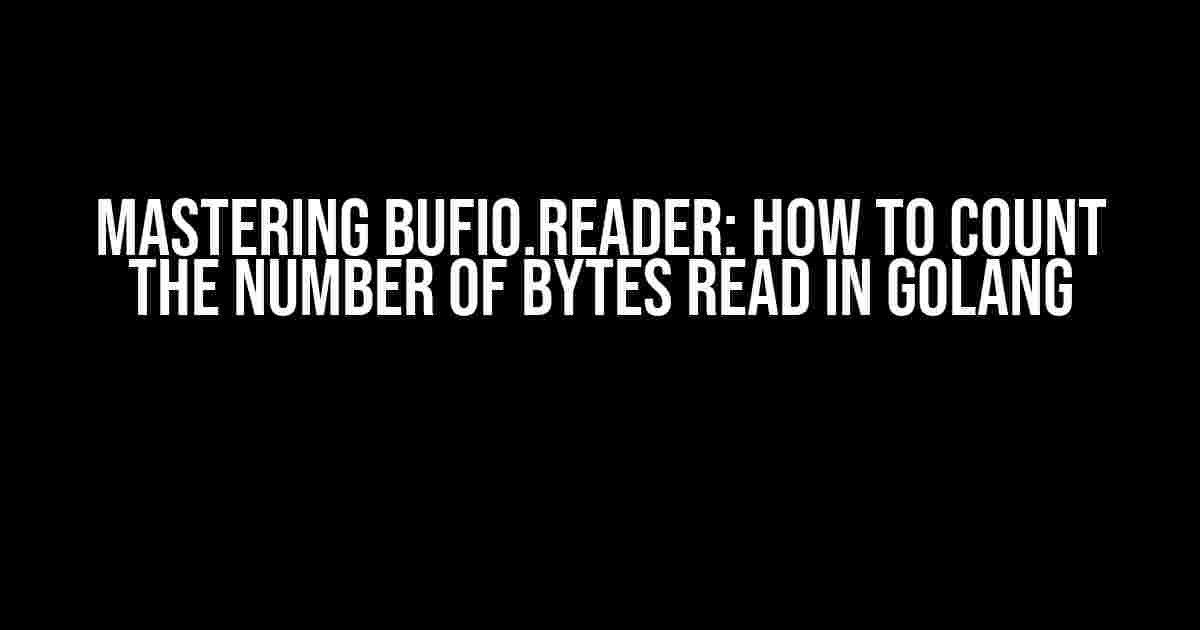Welcome to the world of Golang, where efficient I/O operations are a top priority! When working with bufio.Reader, it’s essential to keep track of the number of bytes read from a data source. In this comprehensive guide, we’ll delve into the world of bufio.Reader and explore the best practices for counting the number of bytes read in Golang.
Understanding bufio.Reader
Before we dive into the nitty-gritty of counting bytes, let’s quickly recap what bufio.Reader is and why it’s so important in Golang.
bufio.Reader is a type of reader that provides a way to efficiently read from a data source, such as a file or a network connection. It’s a buffering mechanism that helps to reduce the number of system calls, making your I/O operations faster and more efficient.
Why Count Bytes Read?
So, why is it crucial to count the number of bytes read from bufio.Reader? Here are a few reasons:
- Performance optimization**: By keeping track of the number of bytes read, you can optimize your I/O operations and identify performance bottlenecks.
- Data validation**: Verifying the number of bytes read ensures that your data is correct and complete.
- Error handling**: Counting bytes read helps you detect and handle errors more effectively.
Methods for Counting Bytes Read
There are two primary methods for counting the number of bytes read from bufio.Reader: using the Read() function and using a custom byte counter.
Method 1: Using the Read() Function
The most straightforward way to count bytes read is by using the Read() function, which returns the number of bytes read from the underlying reader.
package main
import (
"bufio"
"fmt"
"os"
)
func main() {
f, err := os.Open("example.txt")
if err != nil {
fmt.Println(err)
return
}
defer f.Close()
r := bufio.NewReader(f)
buf := make([]byte, 1024)
for {
n, err := r.Read(buf)
if err != nil {
if err != os.EOF {
fmt.Println(err)
}
break
}
fmt.Println("Bytes read:", n)
}
}
In this example, the Read() function returns the number of bytes read from the file “example.txt” and stores it in the variable n.
Method 2: Using a Custom Byte Counter
In cases where you need more fine-grained control over the byte count, you can create a custom byte counter using a variable to track the total number of bytes read.
package main
import (
"bufio"
"fmt"
"os"
)
func main() {
f, err := os.Open("example.txt")
if err != nil {
fmt.Println(err)
return
}
defer f.Close()
r := bufio.NewReader(f)
buf := make([]byte, 1024)
var totalBytes int
for {
n, err := r.Read(buf)
if err != nil {
if err != os.EOF {
fmt.Println(err)
}
break
}
totalBytes += n
fmt.Println("Bytes read in this iteration:", n)
}
fmt.Println("Total bytes read:", totalBytes)
}
In this example, we use a variable totalBytes to keep track of the total number of bytes read from the file.
Best Practices for Counting Bytes Read
When counting bytes read from bufio.Reader, keep the following best practices in mind:
- Use a consistent buffering size**: Ensure that your buffering size is consistent throughout your I/O operations to avoid discrepancies in byte counting.
- Handle errors properly**: Always handle errors returned by the Read() function to avoid incorrect byte counts.
- Reset the byte counter**: Reset the byte counter when necessary, such as when switching between different data sources.
- Consider using a separate goroutine**: If you’re dealing with large amounts of data, consider using a separate goroutine to handle the byte counting to avoid blocking the main goroutine.
| Method | Advantages | Disadvantages |
|---|---|---|
| Using the Read() Function | Easy to implement, efficient | Limited control over byte counting |
| Using a Custom Byte Counter | More control over byte counting, flexible | More code required, potential for errors |
In conclusion, counting the number of bytes read from bufio.Reader is a crucial aspect of efficient I/O operations in Golang. By understanding the different methods and best practices, you can optimize your code and ensure accurate data processing.
Remember, when it comes to counting bytes read, it’s essential to be meticulous and attention to detail. With the right approach, you can unlock the full potential of bufio.Reader and take your Golang skills to the next level!
Frequently Asked Question
Counting bytes read from bufio.Reader in Golang can be a bit tricky, but don’t worry, we’ve got you covered! Here are some frequently asked questions and answers to help you master this skill.
Q1: How do I count the number of bytes read from bufio.Reader?
You can use the return value of the Read() method, which returns the number of bytes read and an error. For example: `n, err := r.Read(b)`, where `n` is the number of bytes read.
Q2: What if I need to read a large amount of data, how do I count the total number of bytes read?
You can use a variable to keep track of the total number of bytes read. For example: `totalBytesRead := 0; for { n, err := r.Read(b); totalBytesRead += n; if err != nil { break } }`, where `totalBytesRead` is the total number of bytes read.
Q3: Can I use a bufio.Reader with a string instead of a byte slice?
No, bufio.Reader requires a byte slice as an argument to the Read() method. If you need to read a string, you can use a bytes.Buffer and then convert it to a string using the `String()` method.
Q4: How do I handle errors when reading from bufio.Reader?
You can check the error returned by the Read() method. If the error is not nil, you can handle it accordingly. For example: `n, err := r.Read(b); if err != nil { log.Fatal(err) }`.
Q5: Can I reset the bufio.Reader to read from the beginning again?
No, bufio.Reader does not support resetting to the beginning of the reader. You need to create a new bufio.Reader from the original io.Reader to start reading from the beginning again.
